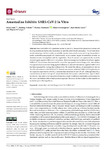Amantadine Inhibits SARS-CoV-2 In Vitro
FInk, Klaus
Nitsche, Andreas
Neumann, Markus
Grossegesse, Marica
Eisele, Karl-Heinz
Danysz, Wojciech
Since the SARS-CoV-2 pandemic started in late 2019, the search for protective vaccines and for drug treatments has become mandatory to fight the global health emergency. Travel restrictions,social distancing, and face masks are suitable counter measures, but may not bring the pandemic under control because people will inadvertently or at a certain degree of restriction severity or duration become incompliant with the regulations. Even if vaccines are approved, the need for antiviral agents against SARS-CoV-2 will persist. However, unequivocal evidence for efficacy againstSARS-CoV-2 has not been demonstrated for any of the repurposed antiviral drugs so far. Amantadinewas approved as an antiviral drug against influenza A, and antiviral activity against SARS-CoV-2has been reasoned by analogy but without data. We tested the efficacy of amantadine in vitro in Vero E6 cells infected with SARS-CoV-2. Indeed, amantadine inhibited SARS-CoV-2 replication in two separate experiments with IC50 concentrations between 83 and 119μM. Although these IC50 concentrations are above therapeutic amantadine levels after systemic administration, topical admin-istration by inhalation or intranasal instillation may result in sufficient amantadine concentration in the airway epithelium without high systemic exposure. However, further studies in other models are needed to prove this hypothesis.
Files in this item

